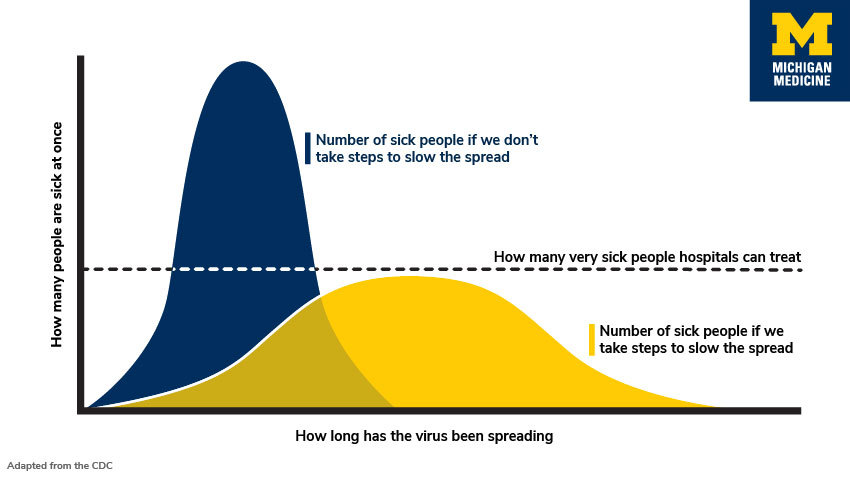 Graphic: Angelina Bambina/Shutterstock
Graphic: Angelina Bambina/Shutterstock
All over the world, policymakers considering how to respond to the Covid-19 pandemic appear to face a stark trade-off between saving lives and preserving jobs and incomes. This is particularly acute in developing countries where large groups of people have extremely limited savings and are especially vulnerable to “economic shutdowns” of any duration. The trade-off originates from the interaction between the epidemiological dynamics of the outbreak and the limited capacity of health systems. This is best illustrated by the “flatten the curve” diagram that has become ubiquitous over the last few weeks. An example, drawn from this blog from Michigan Medicine, is reproduced as Figure 1 below.
Figure 1: Flatten the curve: epidemic intensity versus duration under different policy responses

Simplifying things, the trade-off is essentially that under Strategy 1 (no containment), there is a period where the number of sick people vastly exceeds the capacity of the health system to treat them, and lots of people die: think of it as the blue area above the horizontal dashed line. However, this is soon over: by the rightmost point of the blue curve the epidemic has run its course and people can get back to their jobs, markets and travel plans. Comparatively fewer people will have lost their jobs or fallen into poverty.
Under Strategy 2 (containment), people are locked in at home for a much longer period (to the rightmost point in the yellow curve). Hospitals can handle the daily inflow of patients, so fewer die. But avoidance behaviors last so long that firms fire their workers or go bankrupt, people have no earnings, and poverty rises dramatically.
There have been (at least) two kinds of reactions to this postulated trade-off. Most human beings tend to be shocked that one could even think of a trade-off between incomes and human lives. Surely, they argue, human lives should take absolute priority. A smaller subset of human beings, consisting of most economists (and a few prominent politicians), nod their heads gravely and try to look for an optimal choice somewhere in between. Economists are, after all, brought up on trade-offs, and tend to think of the problem in terms of Figure 2 below: Choose a containment policy – duration and intensity of lockdowns, etc. – so that we end up at point A, saving L0 lives and Y0 “jobs and incomes”, compared to the no-Covid scenario. (The incomes/job axis can be “distribution-adjusted” if you prefer to value the extra dollar or peso accruing to a poor person more highly than that going to a richer person.)
Figure 2: A stylized representation of the trade-off between lives and incomes
Is this a real trade-off? Are economists out to lunch again, as some in the popular press have suggested, or is there a real, extremely important, choice that policymakers must face over the next few weeks? This post suggests that the trade-off is real – but its terms are not fixed in stone. The nature of the trade-off depends a great deal on: (i) social preferences over the valuation of human life; and (ii) the policies and institutions (other than containment) in place in each country to deal with the crisis. Let’s start with preferences:
1. The red curve in Figure 2 is meant to represent “social preferences” between lives and jobs/incomes. It is important to recognize that drawing such a curve necessarily requires us to think of a dollar value for a human life and, of course, agreeing on this “marginal rate of substitution” (as economists call it) is not trivial. Economists tend to start from the technical literature on the valuation of life. There are many approaches, but an influential one typically uses forgone lifetime earnings as a starting point to value a human life. This is not as absurd as it might sound at first. The technique was originally devised to enable us to account for the risk of deaths in evaluating projects: suppose you failed to account for the fact that workers might die building a huge bridge.
Then you’d end up building too many huge bridges. It is important to have some metric by which to factor in the expected cost in terms of human lives.
What this does *not* imply is that these techniques should be used to evaluate human life in all contexts. We are reminded of the famous “Summers memo” back from 1991, leaked to the press, which appeared to suggest that polluting industries should be encouraged to move to poorer countries. Leaving aside the controversy over whether the memo was meant as sarcasm or not, the bigger point is that “valuation of life” techniques are clearly unsuitable for many uses, including for comparing the value of life across different countries or, frankly, across different people. A society may perfectly legitimately choose an alternative basis for valuing life in terms of forgone income. One might argue, for instance, that: (i) the value of human life should be identical across all people; and (ii) that value should be given by the highest willingness to pay observed in society (e.g. how much a billionaire would spend to save his or her ill relative).
I am not necessarily arguing for that particular approach. The point is that such an approach is not a priori ethically inferior to any other, and it would lead to a very different “marginal rate of substitution” between lives and jobs/incomes than, say, standard valuation of life techniques. In other words: the red curve in Figure 1 is not written down in some economics textbook. There is no right or wrong “relative price” of human life. Unlike the price of tomatoes or airplanes, it is a normative matter. One on which policymakers would be well advised to seek to explicitly elicit – and then follow – the dominant preferences in their societies.
2. Let us now turn to policies and institutions, which are incorporated (along with technology and other factors) in the blue curve in Figure 2. Just as the red curve represents “social preferences” that imply marginal rates of substitution between lives and incomes, the blue curve represents the “social technology” through which an economy converts jobs or incomes into lives saved, under a pandemic. It implies the corresponding “marginal rates of transformation” and it is clearly not set in stone either. It is a function of the policies and institutions already in place – and of those that can be quickly deployed – in the realms of health care, labor markets, fiscal redistribution and social protection (to name a few key ones).
For example: In a society in which workers have the right to paid sick leave, the same duration or intensity of containment costs less “income” per life saved than in one where they don’t. A society – like those in many poor countries – where most workers are informal and have no right to unemployment insurance faces a higher “income” cost per life saved than one in which all workers are covered in the short-run. Even in such a context, emergency income transfers – such as Ecuador’s recent doubling the coverage of the Bono de Desarrollo Humano to 400,000 people, or Peru’s emergency Covid-related transfers – can dramatically lower the income cost of each life saved. Conversely, better testing and greater health system capacity (such as in South Korea and, more recently, Chile) require less containment – and thus lower the income costs per life saved.
The bottom line is that, even if the mechanics of how the epidemic interacts with health system capacity do imply a trade-off between lives and jobs/incomes, the terms of that trade-off are not fixed in stone. On the preferences side, the “rate” at which societies are prepared to sacrifice human lives to save jobs and incomes is a normative matter. In a democracy, policymakers – and the economists advising them – would do well to listen to the people. On the “technology” and institutional side, policies that preserve the links between employers and employees (such as temporary payroll tax exemptions conditional on no firing), or that seek to transfer resources to workers when that link is broken, can shift the “production possibility frontier”. When both sides of the problem are taken into account, it is perfectly possible that a policymaker that thinks she is facing the problem in Figure 2 ends up - after taking the pulse of the country on the value of human life and after leveraging all of the macro- and micro-economic policy arsenal at her disposal to preserve jobs and help the unemployed – at point B, rather than A in Figure 3 below.
Moving from A to B – or at least shifting out the blue curve as far and as quickly as possible – is the fundamental challenge facing all countries responding to the Covid-19 pandemic. Preserving jobs or providing income support to those who lose their jobs – particularly for the poorest and most vulnerable in society – can considerably reduce the economic pain caused by the containment needed to save lives. Thereby helping society to make the choice to save more lives.
Figure 3: Policies, institutions and preferences matter for choosing “the right response” in terms of containment




Join the Conversation